Highlights
- This month we launched two new Wikidata courses and we’re extremely pleased to be working with 28 new participants. They represent a host of schools, museums, and organizations such as Carnegie Hall, the Smithsonian Libraries, the Barack Obama Foundation, The Texas Archive of the Moving Image, the Detroit Institute of Art, the National Museum of American History, the Yale University Art Gallery, and the Center for Research Libraries (CRL). This group of participants has some ambitious plans for learning about Wikidata. We are looking forward to the impact they will have on Wikidata and potential they will have to share the collections they represent with the world.
- We attended the Society of Family Planning’s (SFP) annual meeting in Los Angeles to highlight the great work SFP’s 32 Wiki Scholars did over the course of 2 Wiki Scholars courses. We met with 10 of the SFP members who participated in the courses, and we were excited to hear how meaningful these medical practitioners found their experience of learning how to add to Wikipedia.
- We received grant payments from the WITH Foundation and from the Michelson 20MM Foundation. We look forward to engaging in the work supported by these grants.
Programs
Wikipedia Student Program
Status of the Wikipedia Student Program for Fall 2019 in numbers, as of October 31:
- 383 Wiki Education-supported courses were in progress (221, or 58%, were led by returning instructors)
- 6,771 student editors were enrolled
- 61% of students were up-to-date with their assigned training modules.
- Students edited 2,640 articles, created 149 new entries, added 1.22 million words and 13,000 references.
October is the month where students begin to take a deep dive into their Wikipedia assignment. After some introductory edits, they begin to draft their larger contributions and become immersed in Wikipedia culture. This October was no exception.
Wikipedia Student Program Manager Helaine Blumenthal finished onboarding for the Fall 2019 term and was busy getting the program ready for Spring 2020. This means updating materials and records and generally setting things up for the quick turnaround between Fall and Spring. In our ongoing efforts to get the best feedback from instructors, she revised the Fall 2019 instructor survey to reflect the program’s changing needs and goals.
Student work highlights:
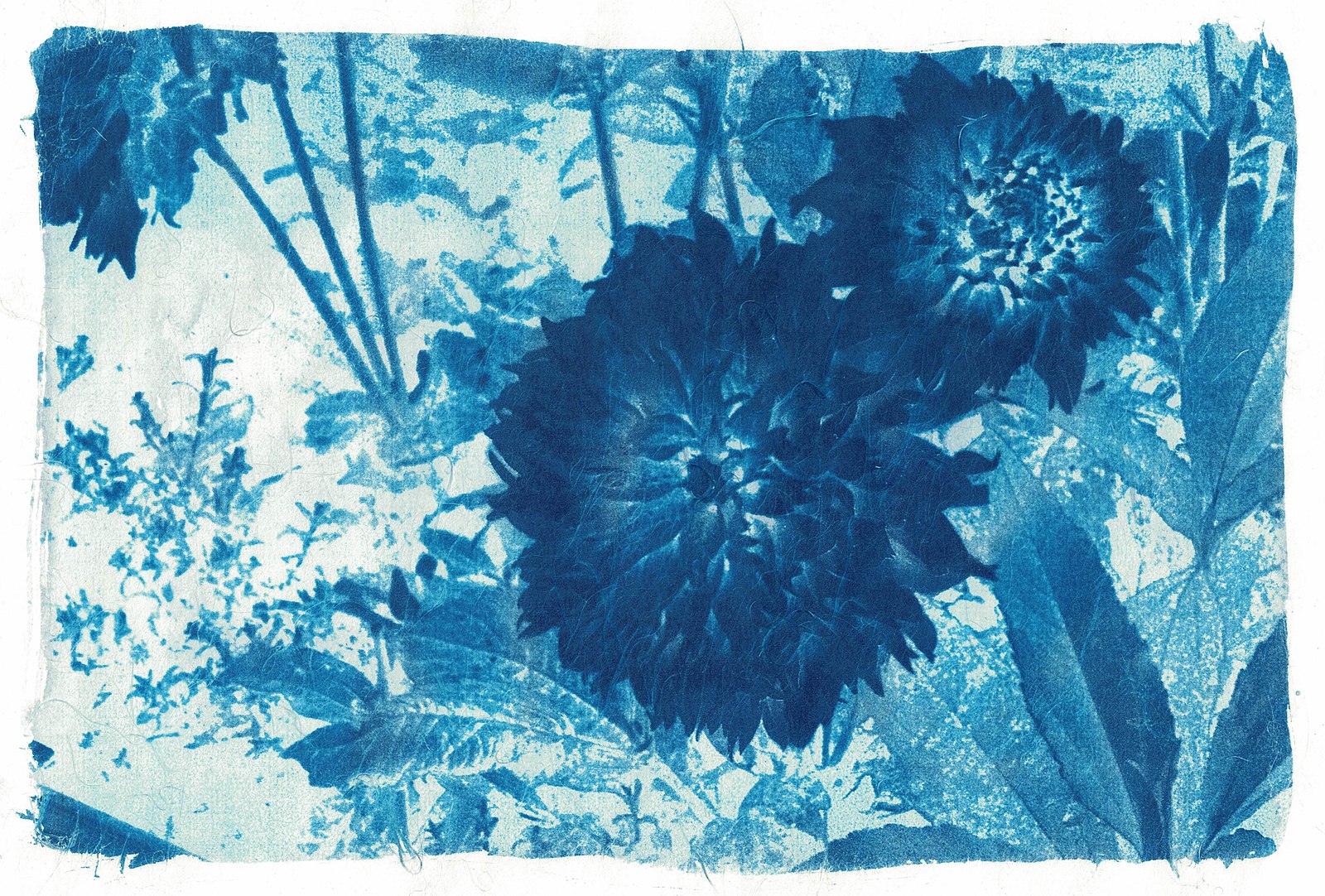
Image by hutschinetto, CC BY-SA 2.0 via Wikimedia Commons.
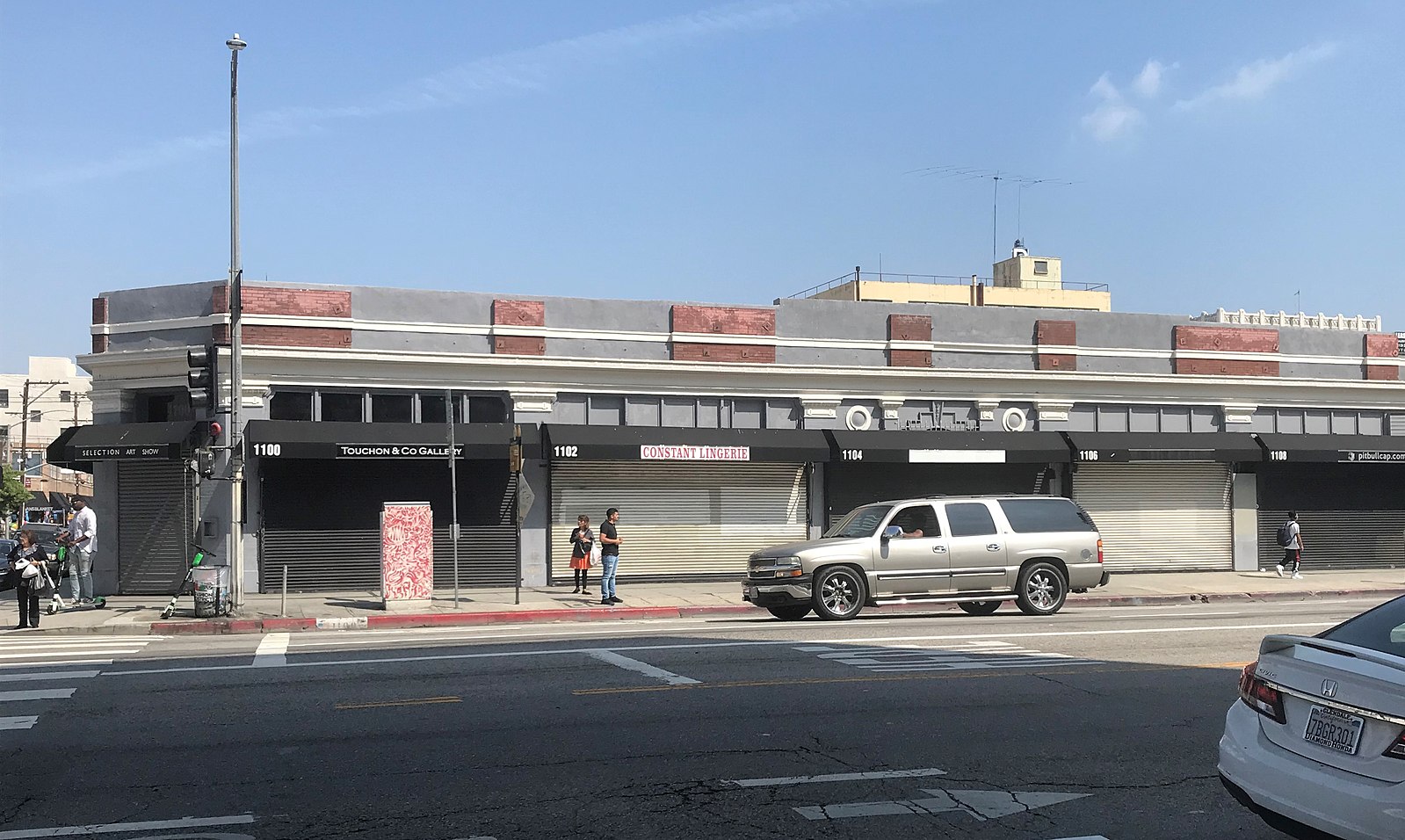
Image by Kreglas413, CC BY-SA 4.0 via Wikimedia Commons.
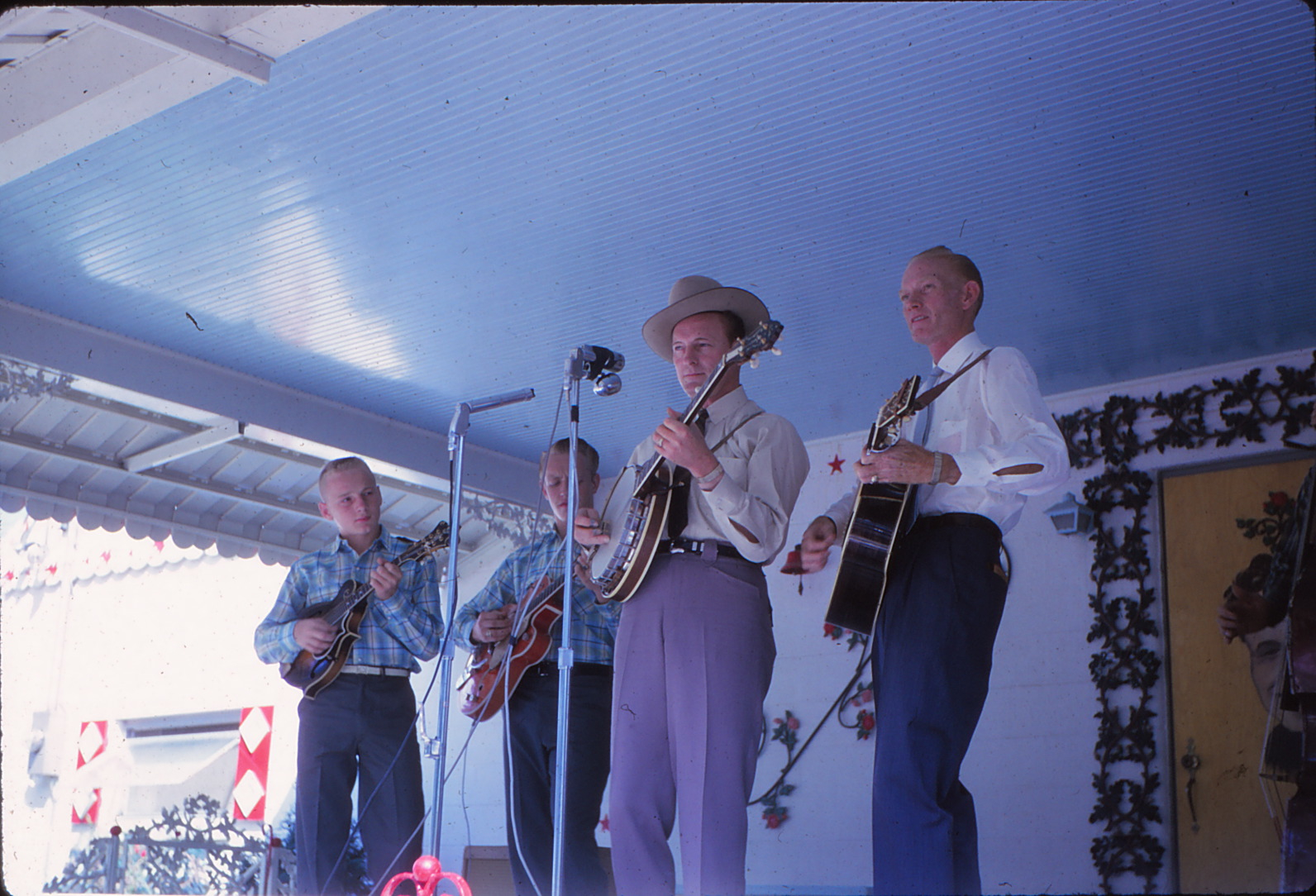
Image by Ann Milovsoroff, CC BY-SA 4.0 via Wikimedia Commons.
Each term students working with Wiki Education create new articles or add content to existing ones. In October, students in Jessica Blackwell’s Gender and Social Justice class at the University of Waterloo chose to work together on creating an article for Elizabeth Smith Shortt, one of the first three women to earn a medical degree in Canada. Despite a hostile backlash from the male staff at students at Queen’s University, Ontario and receiving an expulsion from the same school along with other women medical students, Shortt persevered and completed her studies at a newly established women’s college. She would go on to practice medicine in Hamilton, Ontario, after finishing medical school in 1884 and became an active and long-serving member of the National Council of Women of Canada and spearheaded a number of public health and women’s welfare initiatives. Decades after her death in 1949 two collections of her diaries were published. Her diaries for the years 1872–1884, which include her experiences at medical school, were published under the title A Woman with a Purpose (University of Toronto Press, 1980); her diaries while traveling in Europe with her husband in 1911 were published as Travels and Identities: Elizabeth and Adam Shortt in Europe, 1911 (Wilfrid Laurier University Press, 2017).
If you’re a horror fan, you’re likely familiar with the 1992 film Candyman, a cult classic about a supernatural killer with themes of race and social class in inner-city United States. You may also be aware that up and coming director Nia DaCosta will be working with Jordan Peele on a new film set in this universe. But are you aware that this will be the second feature film she has directed? Last year DaCosta premiered Little Woods at the Tribeca Film Festival, where it was met with a positive reception from critics and received a nomination for the festival’s Best Narrative Feature Award. DaCosta was born in Brooklyn, New York, and raised in Harlem. She became enraptured with film making after watching Apocalypse Now and movies by directors such as Martin Scorsese, Sidney Lumet, Steven Spielberg, and Francis Ford Coppola. She went on to enroll at the New York University’s Tisch School of the Arts, where she would eventually meet Scorsese while working as a TV production assistant. It’s amazing to think that prior to this term DaCosta lacked an article and may have had to have waited longer to have an article, if not for a student in Laura Horak’s Analyzing Cinema, Gender, and Sexuality class at Carleton University.
This was not the only new article created for the class; another student created an article for the Canadian filmmaker, producer, and photographer Zaynê Akyol. Born in Turkey, Akyol predominantly focuses on documentary film and is known for her feature length documentary film Gulîstan, Land of Roses, which was supported by the National Film Board (NFB) and MitosFilm in Germany. Another student chose to expand the article on Canadian film and television director Trish Dolman, who is most noted for her 2017 documentary film Canada in a Day, for which she won the Canadian Screen Award for Best Direction in a Documentary Program at the 6th Canadian Screen Awards in 2018. She has also won multiple awards and is the founder of Screen Sirens Pictures, a production studio based in Vancouver, British Columbia.
People love goats. They’re brought into yoga classes and edited into Taylor Swift music videos. They parkour climb on walls and obstacles, but some goats have an unusual quirk—they faint after being startled. A student in Animal Behaviour at Memorial University of Newfoundland drastically improved Wikipedias article on fainting goats. The student added more information on physical characteristics of fainting goats, and also added information about how the goats’ fainting relates to a medical condition in humans called congenital myotonia. With daily page views numbering more than 450, the student’s work will quickly reach thousands of people, helping them learn more about this topic.
Students in Joan Strassmann’s Behavoiral Ecology class continue working on articles about Diptera, the insect Order that includes flies, fruit flies and mosquitoes. Lutzomyia longipalpis is a sandfly from South and Central America which is a vector for Leishmania infantum, a parasitic protist which causes visceral leishmaniasis, the most severe form of the disease. Although the species (or group of closely related species) is an important vector of this disease, there was no Wikipedia article about it until a student editor in the class created one. The larva of Mallophora ruficauda, a species of robber fly, parasitize the larvae of certain species of scarab beetles. Because the beetle larvae are agricultural pests, M. ruficauda larvae are important biocontrol agents. The adults, on the other hand, prey on bee species, and are an important honeybee predator. Chironomus annularius is a species of non-biting midge which can form the kinds of large swarms commonly associated with midges. Glossina fuscipes is a species of tse-tse fly which spreads African trypanosomiasis. These articles were among those that were created by students in the class during October.
Student work appeared on Wikipedia’s main page in the Did You Know? section twice:
- Template:Did you know nominations/Apple maggot (Appeared on main page 15 October)
- Template:Did you know nominations/Euryoryzomys russatus (Appeared on main page 30 October)
Other new articles include:
Scholars & Scientists Program
Wikidata
New Courses
This month we launched two new Wikidata courses – one beginner and one intermediate. We’re extremely pleased to be working with these 28 new participants. They represent a host of schools, museums, and organizations such as Carnegie Hall, the Smithsonian Libraries, the Barack Obama Foundation, The Texas Archive of the Moving Image, the Detroit Institute of Art, the National Museum of American History, the Yale University Art Gallery, and the Center for Research Libraries (CRL). This group of participants has some ambitious plans for learning about Wikidata. We are looking forward to the impact they will have on Wikidata and potential they will have to share the collections they represent with the world.
You can follow their progress on the Dashboards here and here.
WikidataCon 2019
October also saw the convening of 250 Wikidata editors — including our Wikidata Program Manager, Will Kent — at the second Wikidata Conference in Berlin, Germany. This semi-annual event creates a space for linked data enthusiasts, practitioners, and researchers to gather and talk about Wikidata. Follow this link to review sessions, including recordings, slides, and notes. This year there was a special emphasis on languages in Wikidata. The theme covered supporting endangered languages, pulling in content from less-represented languages on Wikidata, and some tools to help users achieve this. Wikidata also turned seven during this conference. There was a celebration, complete with cake, well-wishes, and presents (in the form of new tools, collections, and bug-fixes!).
In addition to the conference, there was a day-long Wikibase workshop following the conclusion of the conference. Wikibase is the MediaWiki extension that allows users to create, manage, and populate their own instance of Wikidata.
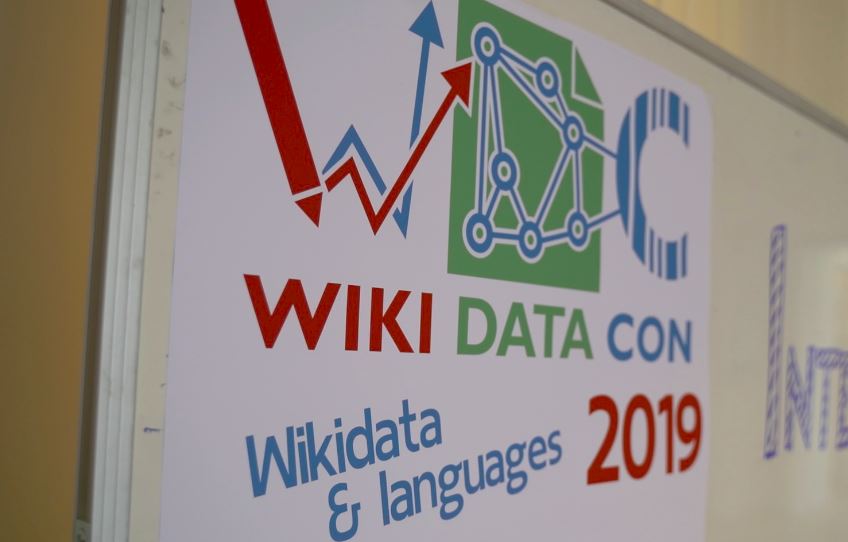
Image by Jan Apel (WMDE), CC BY-SA 4.0 via Wikimedia Commons.
Wikipedia
This month we kicked off a new course in partnership with the University of Massachusetts Lowell focused on improving Wikipedia’s coverage of notable women. The course is part of the university’s Women in Red at UMass Lowell Initiative to teach digital literacy to both faculty and students while increasing the visibility of notable women from the region. Fifteen UMass Lowell faculty joined Scholars & Scientists Program Manager Ryan McGrady and Wikipedia Expert Elysia Webb for the first online meetings early this month. We are excited to help these enthusiastic scholars contribute their knowledge and research to Wikipedia, and to help guide them as they begin teaching with Wikipedia.
We also wrapped up our Wiki Scientists course offered through the New York Academy of Sciences. Nine editors joined us for an 8-week course to understand Wikipedia’s role and potential for communicating science with the public. Participants improved a number of articles. For example, one Wiki Scientist overhauled the article on the nigrostriatal pathway. One of four major dopamine pathways in the brain, it is critical in our ability to move. This is a great example of a complex topic that greatly benefits from contributions by subject-matter experts. Another participant spotted outdated and missing references in the article for immunoglobulin G, the most common type of antibody found in blood circulation. After going through the article, the references are now more reliable and up to date. Finally, articles on big topics like psychologist often struggle on Wikipedia. In this case, one of its problems was that anyone coming to the article and reading the summary in the lead at the top would have a poor overview of what the article actually contains. A Wiki Scientist expanded the lead considerably to better reflect a summary of the subject, for example outlining different kinds of psychologists.
In our course offered with the National Science Policy Network, participants have been hard at work making great contributions to scientific topics relevant to science policy as well as several biographies of women in science. Here are some stand-out examples of articles they have created or improved so far:
- Pathogen, a broad subject covering anything that can produce disease. The article gets upwards of 1,000 views every day.
- Mycobacterium bovis, an aerobic bacterium that causes tuberculosis in cattle.
- Comprehensive Nuclear-Test-Ban Treaty, a multilateral treaty banning all nuclear explosions. It was adopted by the UN General Assembly in 1996, but has not been enforced because there remain 8 nations that have not ratified it.
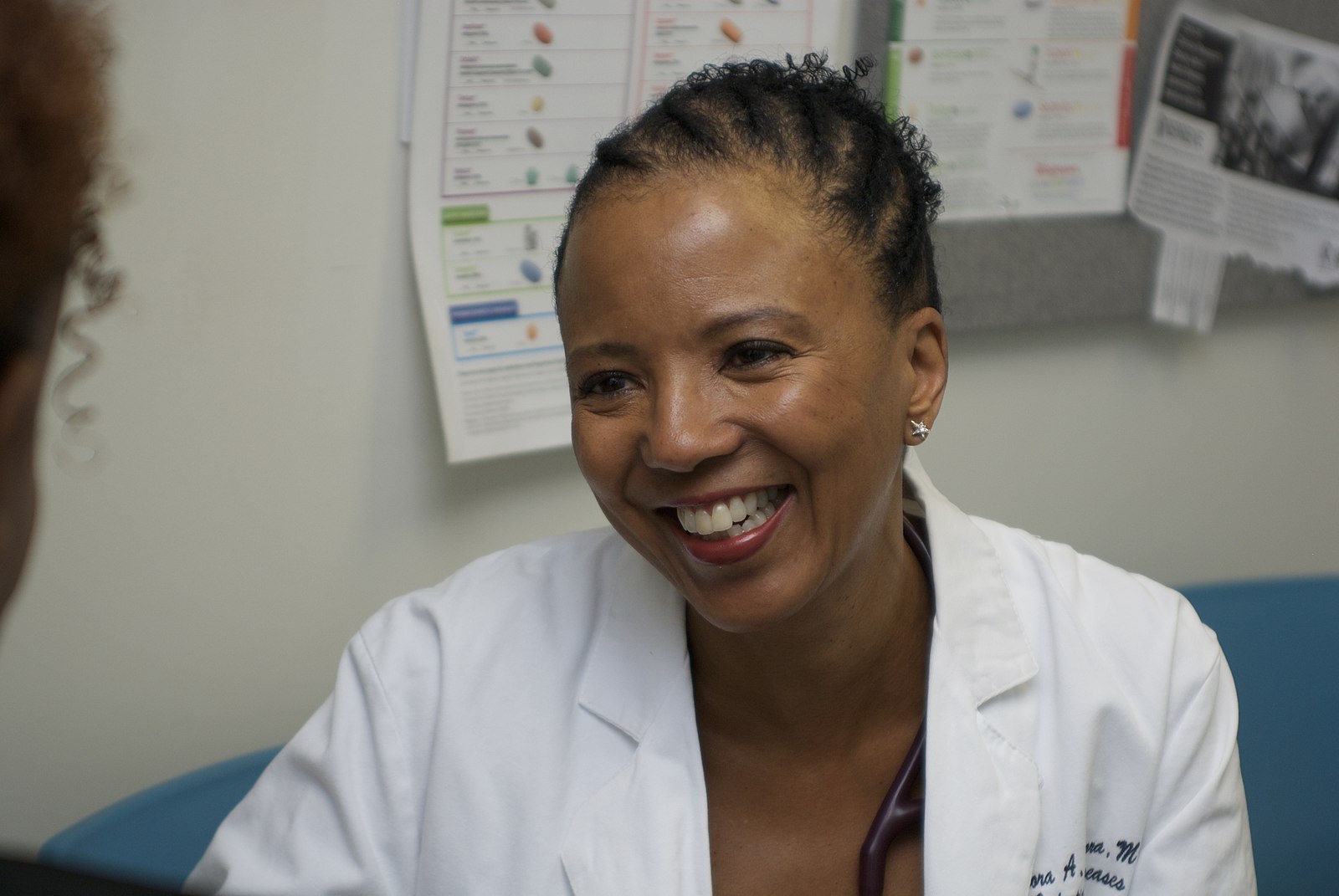
Image by Bradley Allf, CC BY 2.0 via Wikimedia Commons.
- Adaora Adimora, the Sarah Graham Kenan Distinguished Professor of Medicine and professor of epidemiology at the University of North Carolina School of Medicine. She researches the transmission of HIV and other sexually transmitted infections among minority populations.
- Miaki Ishii, seismologist and Professor of Earth and Planetary Sciences at Harvard University.
- Vera Simons, inventor, artist, and balloonist known for high altitude gas balloon development and exploration.
Visiting Scholars Program
The Old Spanish Trail half dollar was struck in 1935, designed and distributed by coin dealer L.W. Hoffecker. The design, which included a cow’s head on one side and yucca tree superimposed on a map of the Gulf Coast states, received mixed reviews and was historically inaccurate. The subject of the coin was Cabeza de Vaca’s travels, but the coin features El Paso prominently, when de Vaca never went there. El Paso, it turns out, is Hoffecker’s hometown. When it was minted, Hoffecker bought them all, said it was for a museum, then sold them to collectors for profit. This unfortunate story in the history of numismatics is now the subject of a Featured Article on Wikipedia thanks to Gary Greenbaum, Visiting Scholar at George Mason University.
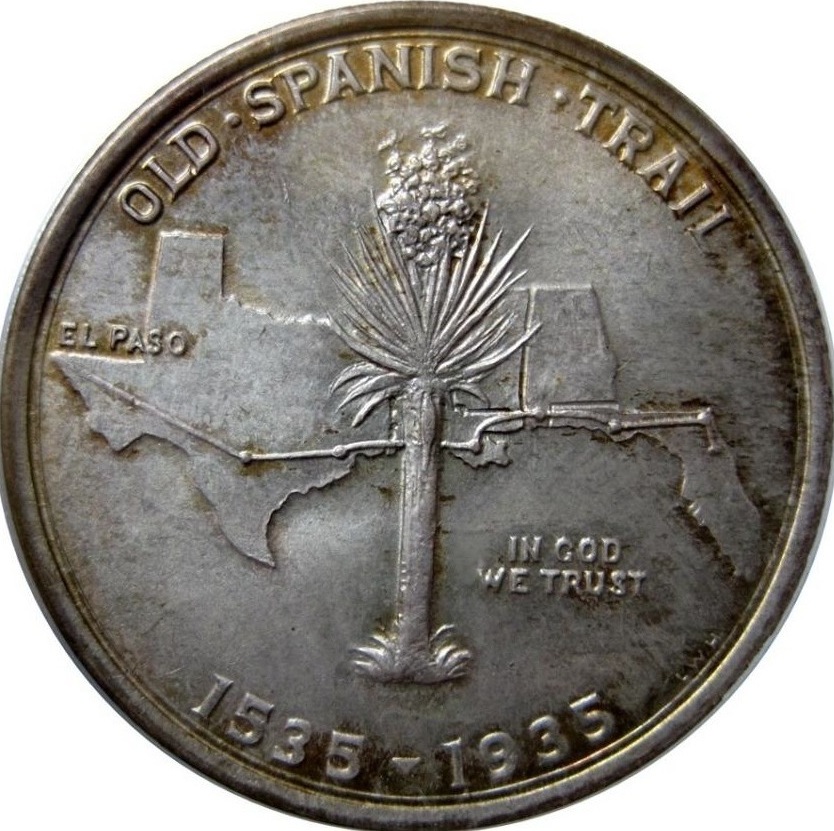
Advancement
Partnerships
There’s a lot of work to be done to create pages for people who identify as women, African-American, Asian, Asian-American, Latinx, indigenous, and LGBTQ+. On Ada Lovelace Day this year, engineers, thinkers, and creators at X set out to help close these representation gaps together. Wiki Education staff joined employees at X to teach them how to add biographies to Wikipedia. Laura Chrobak, an engineering intern, chose conservationist Christa Anderson‘s biography to create. “I truly admire her work,” Laura told Wiki Education. “And through the process of writing the Wikipedia page, I became so impressed with her professional accomplishments and history. I read one of her papers detailing climate change mitigation policy and found her argument and research to be quite compelling. Her work on deforestation and climate policy is incredibly relevant and interesting to me.” We’re excited to see commitment from our Bay Area neighbors to make the internet a more inclusive space.
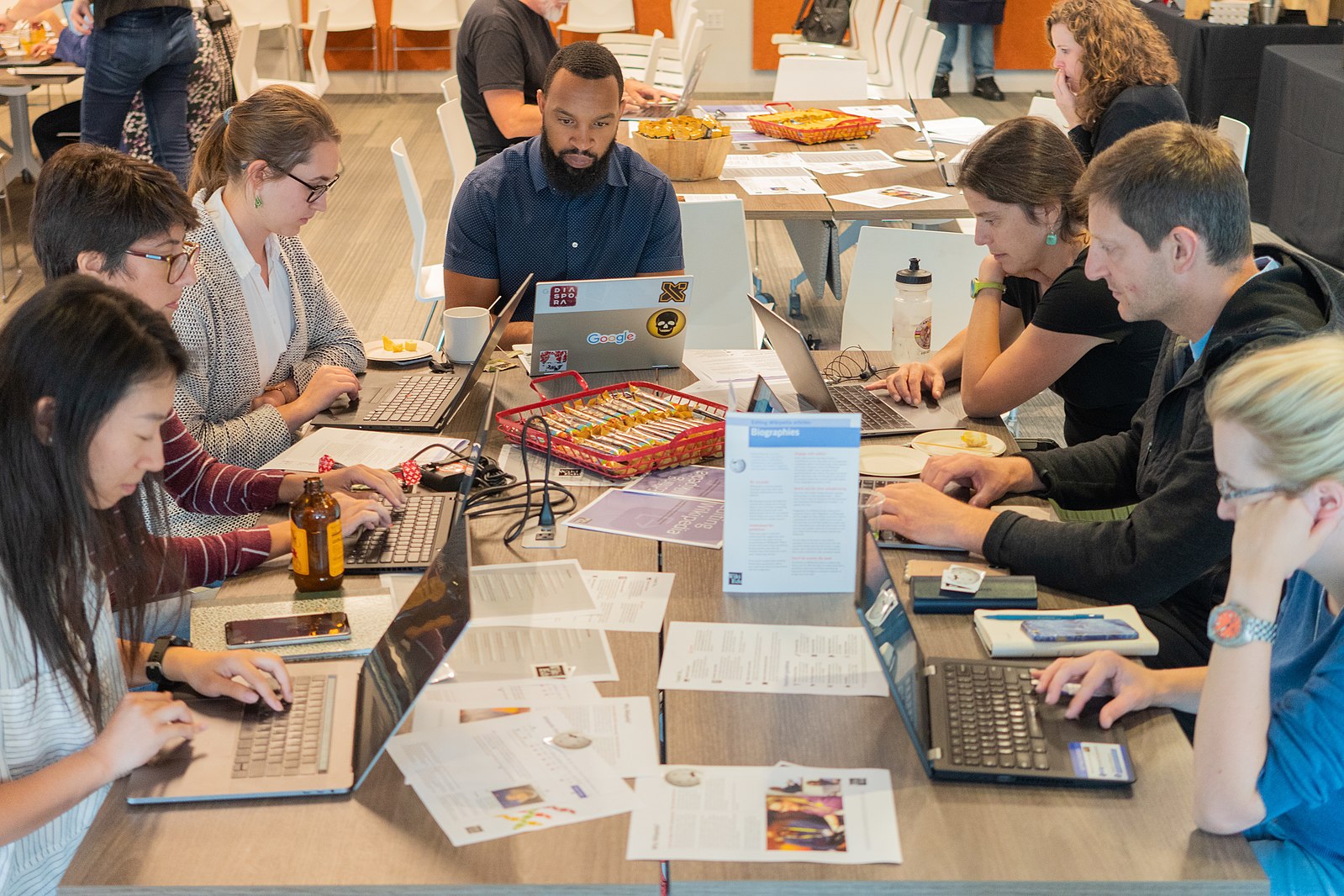
Wiki Education attended the Society of Family Planning’s (SFP) annual meeting in Los Angeles to highlight the great work SFP’s 32 Wiki Scholars did over the course of 2 Wiki Scholars courses. We met with 10 of the SFP members who participated in the courses, and we were excited to hear how meaningful these medical practitioners found their experience of learning how to add to Wikipedia. At the conference, we had the opportunity to present to more than 70 attendees alongside Grace Ferguson, Anne Davis, Bhavik Kumar, and Colleen Denny. We shared why Wikipedia is such an important platform for informing the public with rigorous science, and they each gave insights into their learning outcomes along the way.
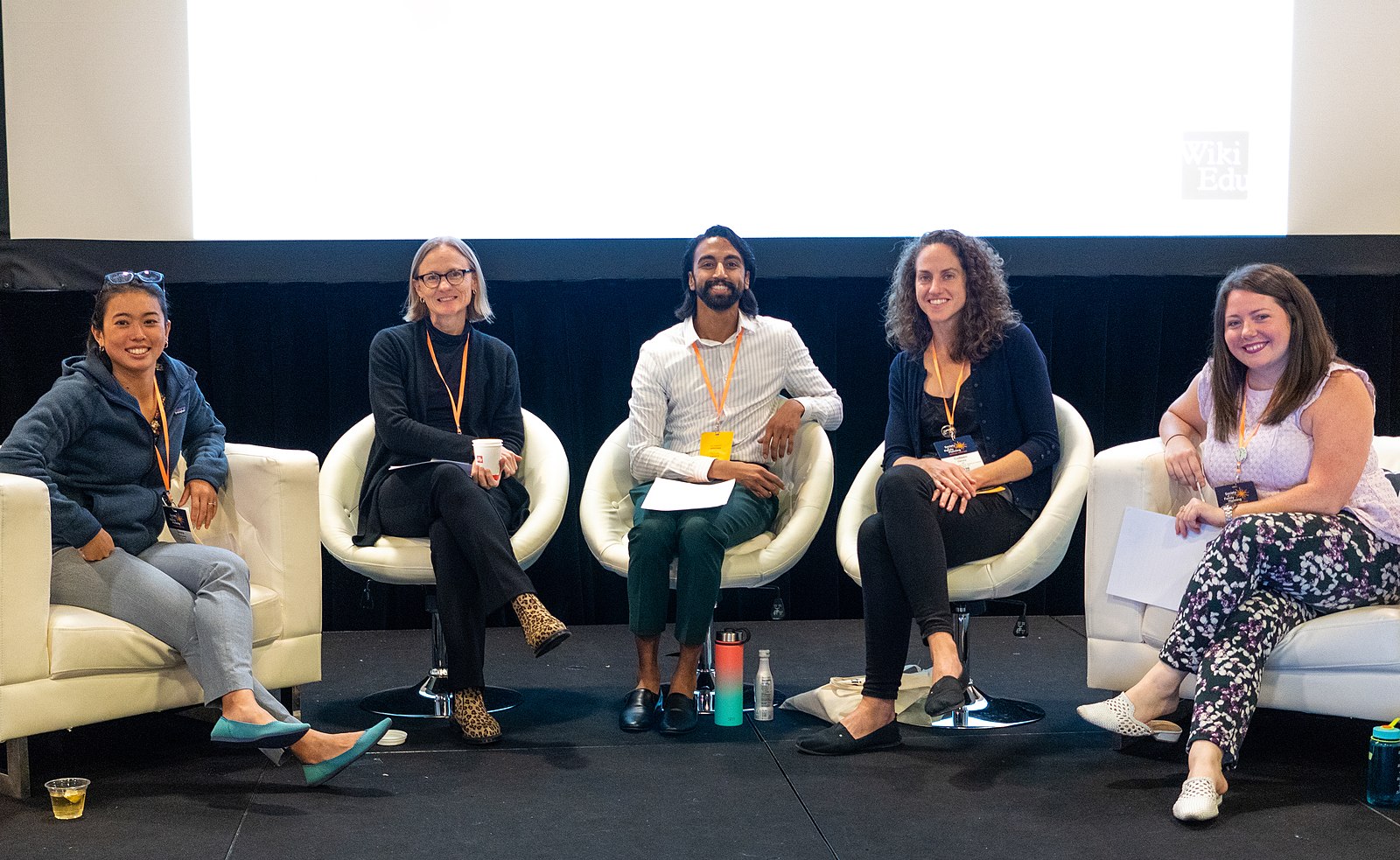
Fundraising
In October, we received grant payments from the WITH Foundation and from the Michelson 20MM Foundation. We look forward to engaging in the work supported by these grants. We also learned that our grant proposal to the Institute for Museum and Library Services was declined for eligibility reasons. We submitted our request for an Annual Planning Grant renewal to the Wikimedia Foundation, and had good conversations with our program officer there. We also had a phone conversation with our program officer at the Moore Foundation about a renewal of our current grant, which ends in November. TJ Bliss, Chief Advancement Officer, traveled to Phoenix at the end of October to attend the annual Open Education Conference. While there, he had face-to-face meetings with our program officer at the 20MM Foundation and with our program officer at the Hewlett Foundation. He also met with Bob Cummings, head of the Fundraising Committee on our Board of Directors.
Internally, we spent a lot of time organizing our fundraising records using Asana and Salesforce. Asana, in particular, has been useful for visualizing the progress we are making with each of our potential and current funders. We focused heavily on identifying and reaching out to potential funders of a Women in Science on Wikipedia Contest, in collaboration with the Smithsonian Institution Archives. Several funders responded positively to these requests, but none invited proposals in October.
Communications
Dr. Alexandra Edwards wrote a guest blog about what happens when students are confronted with a potential audience of 500 million (instead of one). Instructional designer Johnathon Neist shared in another guest blog why he thinks others should get their students involved in the Wikipedia movement. The Wikipedia writing assignment was also featured on the blog of the Human Anatomy and Physiology Society in a piece about the impact that anatomy and physiology students have had on Wikipedia.
Blog posts:
- Bringing the history of Arab cinema to Wikipedia (October 1)
- Writing women back into tech history (October 7)
- Privacy policy updated (October 8)
- Help your library or museum expand the reach of its collections (October 9)
- Students and professionals make Wikipedia more inclusive of women in STEM (October 10)
- What ecologists and Wikipedians actually have in common (October 11)
- Introducing our newest Wikidata enthusiasts (October 11)
- Widening Wikidata’s impact (October 16)
- An Audience of 500 Million: Editing Wikipedia as a Writing Assignment (October 18)
- Wikipedia as an avenue for motivating staff to enact change (October 22)
- An instructional designer’s thoughts on Wikipedia (October 24)
- Writing Latina artists into Wikipedia (October 24)
- Learning about Islamic art and architecture through Wikipedia (October 29)
External media:
Anatomy & Physiology students share their knowledge with the world through Wikipedia. Cassidy Villeneuve. The HAPS Blog. (October 9)
Technology
In October, the Technology team continued work on the set of Dashboard user experience improvements for students that will be rolled out for the Spring 2020 term. The core features — including a progress tracker for each article a student is assigned to edit or peer review, along with improved completion tracking for assigned exercises and on-wiki activities — are complete, and we’ll be scheduling user tests to identify problems and rough edges before the Spring classes get underway.
We also made several performance improvements to handle the ever-larger number of programs, especially on the global Programs & Events Dashboard. We now show pageview stats based on the average rate of views for each article, as it became impractical to keep up exact pageview numbers for every tracked article on a daily basis. We also added pagination to the list of programs in large campaigns, which avoids performance problems that cropped up when browsing the largest campaigns.
Finance & Administration
Overall expenses in October were $181K, ($23K) less than the budgeted plan of $204K. There was an accounting process change to the allocation of indirect operational costs. Due to this change, we will see overspending in General and Administration (as they will no longer re-allocate professional service fees from General and Administration to indirect administrative costs in Programs and Fundraising) and underspending in Programs and Fundraising (for the same reason). An adjustment was made in October to recognize this change for Q1. For the month of October, Governance was in alignment with the Plan. General and Administration was over by $32K of which, +$40K over in Indirect expense allocation: $25K was the Q1 adjustment for the allocation change, +$10K for October professional fees not allocated and +$6K for actual overages in indirect fees. G&A shows underspending in direct professional fees by ($9K), due to the timing of the Audit. Programs were under by ($51K), ($40K) relating to the Indirect allocation addressed above, and ($11K) underspent in Travel. Fundraising was under by ($5K) by not attending a cultivation event ($4K) and ($1K) in indirect cost adjustment.
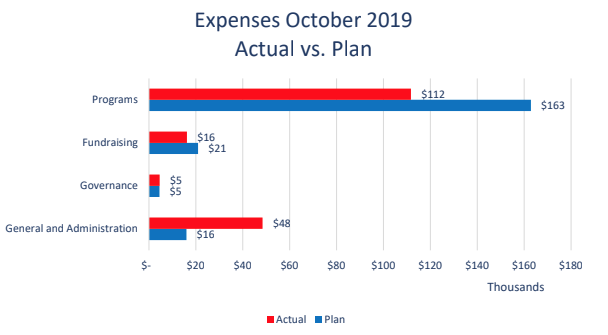
The Year-to-date expenses are $694K ($66K) under budget of $760K. Fundraising, is under by ($5K) due to indirect adjustment ($1K), +$1K in Travel and ($4K) in the cultivation event not attended. The Board is on target. General and Administration is over +$30K. The indirect allocation adjustment +$41K. while underspending in meetings ($14K), Professional fees ($15K), due to timing, and ($2K) in location expenses. Programs are under by ($91K)-($41K) due to the Indirect allocation adjustment, and ($17K) in other indirect allocations. Programs were also under ($26K) in Travel and ($7K) in Communications.
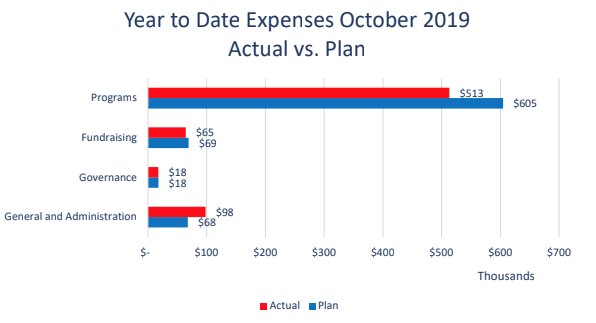
Office of the ED
- Current priorities:
- High-level analysis of the fundraising outlook for the next years
- Embarking on remaining HR projects for this fiscal year
In October, the board’s Finance and Audit Committees conducted a review of our organization’s financial results for Q1 of fiscal year 2019–20. Wiki Education experienced a particularly strong first quarter in fundraising, while our revenue through earned income was slightly lower than projected. Overall, Q1 results have been higher than projected.
Also in October, the board’s HR committee and Frank started a conversation about updating Wiki Education’s salary structure. From day one on, our organization has been extremely frugal and careful about what we spend donor money on. At the same time, increases in the cost of living in the San Francisco Bay area over the past couple of years have made our staff’s lives extremely difficult at times, given that our salary structure is still based on a now-outdated analysis from six years ago. In order to continue being able to attract the best talent and maintain our track-record of a very low turnover ratio, Frank and Ozge will deep-dive into analyzing whether the pay for each individual position is still adequate or whether small adjustments have to made.
At the beginning of October, we released our new vacation policy. The new policy, which had been in the works for a while, takes the realities of a modern work biography into account and provides Wiki Education hard-working staff with sufficient time off to recharge their batteries, and stay healthy and productive.
Visitors and guests
Michael Schulte, founder of Klexikon, the German online encyclopedia for children aged six to twelve years
